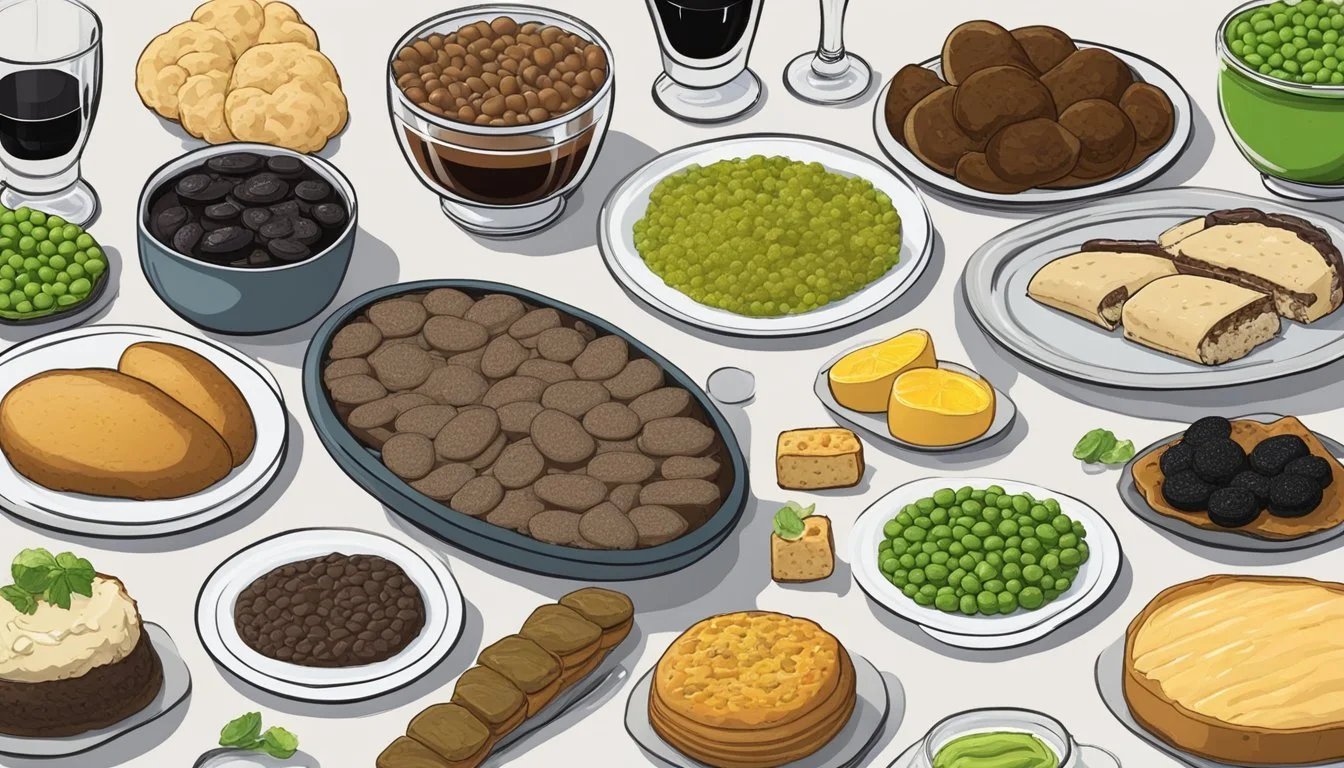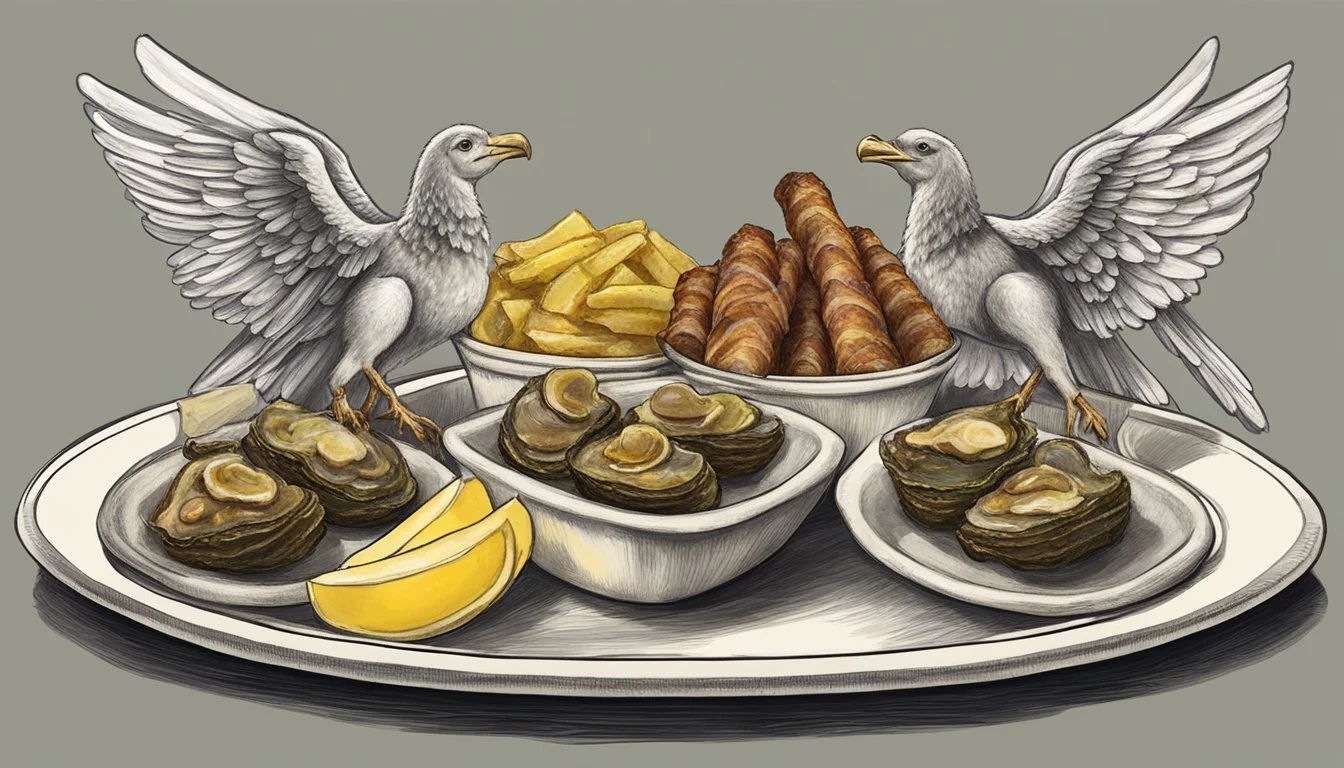10 Weird Foods from the UK
Unusual Dishes You Have to See
British cuisine often presents a delightful mix of history, culture, and unexpected flavors. Across the UK, there are numerous dishes that might seem unusual to new eyes and palates, yet offer an authentic taste of the nation's culinary heritage. Exploring these foods is not only an adventure for the taste buds but also an insight into traditions that have been preserved and adapted over centuries.
Readers will find that many of these dishes reflect regional ingredients and historical cooking methods, offering a varied gastronomic experience. While some might initially appear peculiar, they embody the rich diversity of British culinary innovation. From the comforting to the curious, the following exploration delves into ten of the most distinctive foods from the UK.
1) Stargazy Pie
Stargazy Pie is a traditional Cornish dish known for its unique and striking presentation. The pie is made with whole pilchards or sardines, which are arranged so that their heads stick out through the top crust. This peculiar arrangement gives the appearance of the fish gazing at the stars, hence the name.
Originating from the village of Mousehole in Cornwall, Stargazy Pie is often prepared to celebrate Tom Bawcock's Eve. This local festival commemorates a legendary fisherman who braved a storm to bring back enough fish to feed the starving villagers during a famine.
The pie typically contains a rich and savory filling of fish, eggs, and potatoes, often enhanced with bacon, onions, and herbs. The protruding fish heads are a critical aspect of the dish, as they allow the oils to drain back into the pie, enriching the flavor.
Stargazy Pie's unusual appearance might be off-putting to some, but it is deeply rooted in Cornish heritage. The dish symbolizes bravery and resourcefulness, qualities celebrated by the community through its preparation and consumption.
Whether as a curiosity or a culinary adventure, Stargazy Pie remains a fascinating example of traditional British cuisine.
2) Haggis
Haggis is one of Scotland's most famous dishes and often sparks curiosity due to its unique ingredients. Traditionally, it contains sheep's heart, liver, and lungs, mixed with onions, oatmeal, suet, spices, and salt. The mixture is then encased in the animal's stomach and cooked.
Despite its Scottish origins, variations of haggis can be found across Europe. For example, Norway offers a vegetarian version, demonstrating the dish's adaptability.
In 1984, the first vegan haggis was introduced, making the dish accessible to a broader audience. This version replaces the meat with a blend of cereals, legumes, and vegetables but retains the distinctive spicy flavor.
Haggis typically features on the menu during Burns Night, a Scottish celebration honoring poet Robert Burns. The dish is often served with "neeps and tatties" (turnips and potatoes) and enjoyed alongside a dram of Scotch whisky.
Although some may find the concept of haggis unappealing, it remains a beloved symbol of Scottish cuisine and culture. Exploring its various forms, from traditional to vegan, provides an insight into the culinary heritage of Scotland.
3) Black Pudding
Black pudding is a traditional British dish that often raises eyebrows due to its unique ingredients. It is a type of blood sausage made from congealed pigs' blood and oatmeal. Despite its unusual composition, black pudding is a staple in many English breakfasts.
This sausage is typically seasoned with herbs like thyme and spices such as black pepper. It's commonly fried and served alongside bacon, eggs, and toast. Black pudding can also be enjoyed cold, though it’s less common.
Many people are surprised to find that black pudding can be quite tasty. The combination of savory blood and wholesome oatmeal creates a rich, distinctive flavor. It has a firm texture, which some might find off-putting at first but grows on many who give it a try.
Despite its roots in British cuisine, variations of black pudding can be found worldwide. However, the British version holds its own unique place in their food culture, cherished by many for its hearty and robust profile.
4) Spotted Dick
Spotted Dick is a traditional British dessert that often raises eyebrows due to its unusual name. It is a type of suet pudding that contains dried fruits such as currants or raisins, which give it the "spotted" appearance.
This classic dish is typically steamed rather than baked, which results in a moist, dense texture. It is usually served hot, often accompanied by custard or sometimes a drizzle of cream to enhance its rich flavors.
The primary ingredients include flour, breadcrumbs, suet, sugar, and dried fruits. These components are mixed together to create a dough, which is then steamed for several hours. The steaming process ensures the pudding remains soft and retains its moisture.
Spotted Dick has been enjoyed in the UK for centuries and continues to be a popular dessert in both homes and restaurants. While the name might elicit a chuckle, the dessert itself is a beloved part of British culinary history.
5) Laverbread
Laverbread, known as "bara lawr" in Welsh, is a traditional delicacy made from a specific type of seaweed called laver or Porphyra umbilicalis. This seaweed grows naturally along parts of the Welsh coast.
Once harvested, the laver is thoroughly washed and then boiled for several hours, turning it into a thick, dark green paste. This paste can be eaten as is, often enjoyed with toast or mixed with oatmeal and fried into patties.
Laverbread is rich in nutrients, particularly iodine and other minerals. This peculiar dish is often paired with bacon or cockles for a hearty Welsh breakfast.
Despite its name, laverbread has no connection to bread. Instead, it derives from the word "bara," which means bread in Welsh, due to its spreadable consistency.
The unique texture and strong, salty flavor may not appeal to everyone, but for those who try it, laverbread offers a distinct taste of Welsh cuisine.
Though it may look unappetizing to some, laverbread remains a beloved part of Welsh culinary tradition, reflecting the resourceful use of local ingredients. This seaweed delicacy continues to be celebrated for both its historical significance and nutritional value.
6) Jellied Eels
Jellied eels are a traditional British delicacy that originated in the East End of London. Known for their unique texture and flavor, they have been a staple in the area since the 18th century. The dish involves eels, which are cleaned, chopped into pieces, and boiled.
The boiling process releases gelatin from the eels, creating a naturally thickened stock. This stock is seasoned with herbs, vinegar, and spices, providing a distinct taste. Once cooled, the liquid forms a jelly-like consistency around the eel pieces.
Typically, jellied eels are served cold. They can be eaten straight from a bowl or combined with pie and mash, another classic London dish. Their flavor is mildly fishy with a slight tang from the vinegar and herbs.
Though not as popular today, jellied eels still hold an iconic place in British culinary history. They represent the resourcefulness of London's working-class communities, who made the most of locally available ingredients. For those curious about traditional British foods, trying jellied eels offers a glimpse into the country's rich culinary past.
7) Marmite
Marmite is a unique and divisive British food spread, known for its intense salty flavor. Made from concentrated brewer’s yeast, it was first sold in 1902. Marmite is promoted as a health food due to its high vitamin B and folic acid content.
This sticky, brown paste is often enjoyed on toast with butter. Despite mixed opinions, many Brits have a strong preference, either loving or hating it. The phrase "love it or hate it" embodies its polarizing taste.
In some recipes, Marmite is used to enhance the umami flavor. For example, a spoonful can be added to spaghetti with melted butter and garlic. Its unusual taste and versatile use make it a noteworthy British staple.
8) Kippers
Kippers are a traditional British dish made from herring. The fish is split open, cleaned, salted, and then smoked. This preparation method dates back centuries and is a staple in many British households.
Typically, kippers are served for breakfast. They have a distinctive smoky flavor and a rich, oily texture. While their strong aroma might be off-putting to some, kippers are beloved by many for their unique taste.
Enjoyed with buttered toast or a poached egg, kippers can make for a hearty start to the day. They are often accompanied by a splash of lemon juice, enhancing their smoky profile.
Despite their polarizing smell, kippers remain a popular dish across the UK. They are widely available in supermarkets and fishmongers. This dish showcases the British knack for preserving and maximizing the flavors of simple ingredients.
9) Pork Scratching
Pork scratchings are a popular British snack made from pig skin. The skin is salted and deep-fried until crispy. This process results in a crunchy texture that many find highly addictive.
The origin of pork scratchings dates back to the working-class kitchens of the Black Country in the West Midlands. Traditionally, they were made at home from leftover pig skin, ensuring nothing went to waste.
Different regions in the UK have their own variations. Some add spices, while others keep it simple with just salt. Despite regional differences, the basic preparation method remains consistent.
Pork scratchings can be found in pubs and stores throughout the UK. They are often enjoyed as a snack with a pint of beer.
Nutritionally, pork scratchings are relatively high in protein but also contain significant levels of fat and sodium. A small serving can pack a lot of flavor and crunch.
Making pork scratchings at home is fairly straightforward. The skin is first cleaned, boiled to soften it, and then baked or fried until it turns golden brown. This homemade version can be seasoned to taste, offering a customizable twist on this classic snack.
10) Angels on Horseback
Angels on Horseback is a classic British dish that originated in the Victorian era. This intriguing hors d'œuvre involves oysters wrapped in bacon and grilled or baked until the bacon is crispy.
The combination of the tender oyster and the salty bacon creates a unique flavor profile that has intrigued food enthusiasts for generations.
The name "Angels on Horseback" is thought to derive from the visual appearance of the bacon, which curls up during cooking, resembling angel wings. Traditionally, this dish is served hot, often as a canapé atop bread.
Lemon juice is sometimes drizzled over the top for added zest. While its popularity has waned in recent decades, it remains a fascinating part of Britain's culinary heritage.
Modern variations may include skewering the oysters or frying them instead of baking. Angels on Horseback offers a glimpse into a time when oysters were considered common fare rather than a luxury.
This dish, simple yet elegant, captures the essence of historic British cuisine.
Cultural Significance of Unique British Foods
Unique British foods reflect the rich culinary history of the UK and their integration into modern dining highlights their enduring appeal. These dishes serve as cultural touchstones, preserving traditions while adapting to contemporary tastes.
Historical Context
British cuisine evolved through centuries of social and economic change. Many dishes, such as Pease Pudding and Scotch Eggs, originated in times when resourcefulness was key. Pease Pudding, made from yellow split peas, dates back to medieval times when legumes were a staple. It was often paired with ham or gammon to stretch food supplies.
Bangers and Mash gained popularity during World War II due to rationing. Sausages, or "bangers," were so named because their high water content caused them to burst when cooked. These dishes reflect historical efforts to create hearty meals from limited ingredients, giving insight into the resourceful nature of British cooks.
Modern Popularity
In contemporary Britain, these dishes have found renewed interest. Scotch Eggs, once a picnic staple, are now trendy bar snacks, appearing on gastro-pub menus across the UK and beyond. This resurgence showcases how traditional foods can be reimagined for modern palates.
Bangers and Mash remain a comforting pub classic, while dishes like White Pudding, an oatmeal sausage, have gained attention among food enthusiasts. This dish, combined with the rising interest in regional cuisines, has helped these foods transcend their humble origins. Embracing these unique dishes in today's culinary scene highlights the UK's ability to innovate while respecting its gastronomic heritage.
Health Aspects of Unconventional UK Dishes
Unconventional UK dishes can be intriguing, yet they often prompt questions about their nutritional value and dietary impact. Analyzing these aspects can offer a clearer picture of their health implications.
Nutritional Insights
Unconventional UK dishes like haggis, black pudding, and bangers and mash harbor unique nutritional profiles. Haggis, made from sheep's organs like the heart, liver, and lungs, is high in protein and iron but also contains significant fat and cholesterol.
Black pudding, a type of blood sausage, is rich in protein, iron, and zinc. However, it is also high in saturated fats, which can impact cardiovascular health if consumed in large quantities.
Spotted dick, a suet pudding with dried fruit, provides carbohydrates and minerals but also contains high sugar and fat levels. Similarly, Scotch eggs, comprising a hard-boiled egg wrapped in sausage meat, offer protein but come with added fats and calories due to their fried preparation.
Dietary Considerations
Dietary considerations are essential when consuming unconventional UK dishes. Those with cholesterol concerns should limit intake of rich, fatty items like black pudding and Scotch eggs. Additionally, individuals who require low-sodium diets should be cautious with processed meats like bangers in bangers and mash.
Gluten intolerances are another aspect to consider. Dishes containing oatmeal, barley, or suet may contain gluten, making them unsuitable for individuals with celiac disease.
People with dietary restrictions can explore modified recipes or alternative ingredients to enjoy these culinary delights safely. With thoughtful preparation, the unique flavors of these dishes can be experienced without compromising health.





